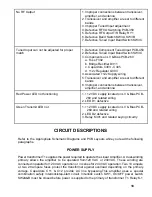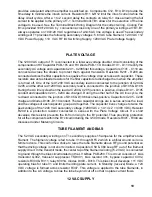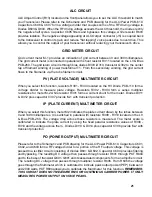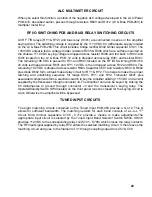
9
Neutral
White
Blue
Ground (Earth) Green
Green/Yellow
Use the following NEMA plug configurations according to the corresponding AC line voltage:
100/110 VAC 20 Ampere 5-15P
200/240 VAC 10 Ampere 6-15P or 6-20P
Due to the power involved, this Amplifier should have its own 240 VAC electric service line. This
line should have three 12-gauge conductors, and 10 ampere fuses in each "hot" wire. If a single
240 VAC line serves the entire station, make an effort to connect your equipment so the load is
balanced between the two "hot" wires.If you have only 120 VAC available, use a separate line
made up of 10 gauge conductors and 20 ampere fuses in each leg of the circuit.
DO NOT
use this
Amplifier at it full ratings on a regular house wiring circuit, as the ratings of the wire will almost
certainly be exceeded. Avoid excessively long runs of wire between your service entrance and
the Amplifier. A heavy flow of current in such a line results in a voltage drop which can affect the
performance of your equipment. The plug on the power cord of your Amplifier, if wired for 120
VAC operation, is for standard 120 VAC outlets (NEMA 5-15P). If the Amplifier is wired for 240
VAC operation, no plug is supplied with the line cord. Use a plug that matches your 240 VAC
receptacle (NEMA 6-15P or 6-20P). Your power connection must conform to section 210-21 (b)
of the National Electric Code, which reads, in part:
"Receptacles connected to circuits having different voltage, frequencies, or types of current (AC
or DC) on the same premises shall be of such circuits are not interchangeable."
When you install a new plug, make sure it is connected according to your local electrical code.
Keep in mind that the green line cord wire is connected to the Amplifier chassis.
ANTENNA
The output circuit of the Amplifier is designed to be connected to an unbalanced transmission line
that has a 50 ohm characteristic impedance. Lines of other characteristic impedance may be used
providing the SWR (standing-wave-ratio) does not exceed 2:1. In addition, the built-in wattmeter
is only accurate at 50 ohms.The RF OUT connector is a UHF type SO-239. You will need a
mating PL-259 plug for your transmission line.Use coaxial cables like RG-8U, RF-11U, or similar
types, for the transmission line. Due to the power level, the smaller types RG-58U, RG-8X, and
RG59/U are not recommended.The "A.R.R.L. Antenna Book" is readily available and includes
comprehensive reference work on transmission lines and antennas. Other similar handbooks for
the radio amateur are offered for sale and can often be found in a public library.
GROUNDING
Connect a good earth or water pipe ground to the ground post on the rear of the Amplifier. Use
the heaviest and shortest connection possible. Before you use a water pipe ground, inspect the
connections around your water meter and make sure that no plastic or rubber hose connections
are used. These connections interrupt the continuity to the water supply line. Install a jumper
around any insulating water connectors you may find. Use heavy copper wire and pipe clamps.
It is best to ground all equipment to one point at the operating position and then ground this point






















